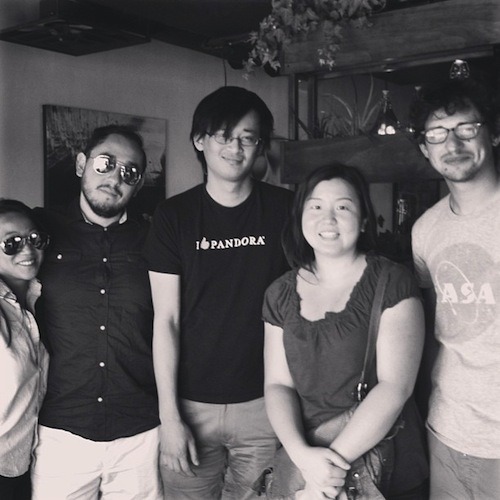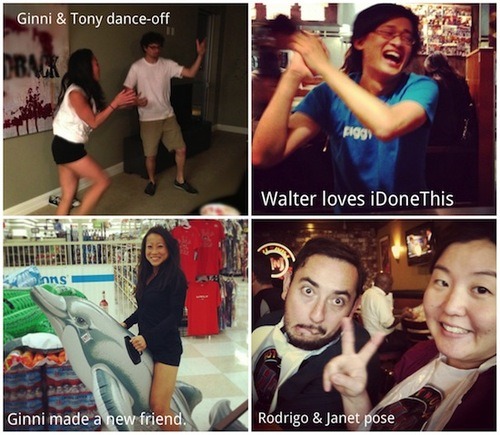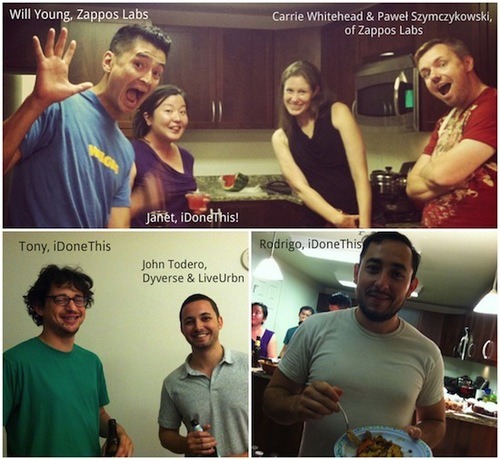
If you’ve ever had to suffer through trust fall exercises or offsites that try to make over ugly corporate morale in one go, you probably dismiss company retreats as a waste of time and money.
Yet the company retreat remains one concrete strategy that startups employ to fuel their success. When you work for a startup, where every day is basically a trust fall, a company retreat is not just a superficial motivational exercise in decreeing “let’s do better” but an opportunity to take a step back and realign, rethink, and break down how to do better.
In July, I Done This went on a week-long team trip to downtown Las Vegas to do just that. While we’d visited before to connect with Zappos and the Downtown Project, this year things are a bit different: our CEO Walter lives in Vegas and we’re proud to be in the Vegas Tech Fund portfolio alongside exciting companies like Zirtual, LaunchBit, and Skillshare.
We had a fantastic time connecting with the Vegas startup and Downtown Project community, working out some of our own company kinks, and of course, having fun. We thought we’d share some tips on what made our all-hands trip effective to consider for your own company retreats, offsites, or meetups!
1. Retreat to a higher level to reflect, problem-solve, and prioritize.
Despite the label, a company retreat isn’t a withdrawal or escape from work but an opportunity to lean into it on a higher level. Retreat from “business as usual” mentalities in order to better reflect on and have critical conversations about direction, problem-solving, and priorities.
The team behind the e-reader app Readmill views their company retreat as a window to “take a break, peel back a layer, and talk about who we are, what we’re doing and why we’re doing it. The so-called three w’s.” That stepping back allows you to set larger goals and align depth of vision.
During our week in Vegas, we had a chance to dig into questions such as:
- how can we improve our individual and collective productivity?
- how can we rethink our development process to better pinpoint and handle unknowns?
- what and how should we build next?
These “peel back a layer” conversations are harder to initiate and sustain when we’re all focused on trying to get stuff done, which means that a company retreat is a great chance to have them. Our sessions were specifically scheduled but the content was more free-spirited. We wanted to get away from the stolid spirit that meetings can slide into and gain a bit of elevation instead.
2. Find a good place to work.
Remote workers understand the challenge of coming by dependable internet outside an office environment. Finding a relatively quiet place with decent internet (and decent coffee) can be quite the treasure hunt. Luckily we were able to spend much of our time at the downtown co-working space Work in Progress, alongside other Vegas startups enjoying its natural light, meeting rooms, and super fast internet.
Wherever you plan your company retreat or offsite, make sure working internet and quiet meeting spaces are available beforehand to prevent wasting precious time and patience scrambling for workarounds.
3. Disconnect from devices during your company retreat
Connecting as human beings takes effort, and because we’re a distributed company, we’re hyper-aware of the importance of cultivating team camaraderie. CEO of Auttomatic Toni Schneider figures that spending dedicated time to get together would be “beneficial to any company … to deepen personal connections and get to know the ‘people behind the jobs’.”
So step away from the computers and phones.
Use mealtimes as a chance to connect. We cooked and ate together and became repeat customers at the delicious, cosy EAT. Opened by Natalie Young, a former chef at places like the MGM Grand, EAT was one of the Downtown Project’s first small business investments and stands as a model for the revitalization effort, literally nourishing the neighborhood and thankfully nourishing us.

We sang our hearts out at karaoke (and might have had more than one impromptu singing and/or dance sessions), had supermarket adventures, and checked out the downtown scene.
The unplanned fun was just as key as the planned — what was important was that we had the space to have it.
Getting to know the people behind the jobs can sound a bit hokey, but it’s especially valuable for people who don’t see each other face-to-face regularly, who tend to interact less because of the nature of their jobs, and who are often collectively heads-down, working away.
4. Connect, empower, and learn with the people around you.
As part of the Vegas Tech Fund, we’re lucky to be a distributed team who’s also growing roots in a physical place. As a way to get to know the Vegas tech community better, we turned to food and moonshine, throwing an I Done This potluck at Walter’s apartment. It was a friendly, low-key way to meet people we saw regularly at the co-working space and get to know other startup folks in the area.

We also helped put on a Vegas Tech Fund mini-summit of product sessions, a day-long version of the speed-feedback events started by Gary Chou and Christina Cacciopo pairing creators and startups with advisors.
Community isn’t just about connecting but also about empowerment. And we figured that bringing in startup mentors and experts into the world of the Downtown Project and helping each other grow as companies was a cool way to learn, connect, and empower in a supercharged way.
5. Manage energy rather than time.
If you’re going on a longer trip that requires regular work, keep in mind that a change in scenery and increased time spent with others can detract from usual levels of productivity. Even when your meetups are shorter — say a one- or two-day offsite — it’s important not to overpack your schedule, which will take its toll on people’s energy and enthusiasm, and ultimately the effectiveness of the outing. Most people need time to decompress and rest — from both work and fun activities.
As for us, we limited most of our strict planning to the product sessions, certain meals out and social events that required pre-arrangements, invitations or reservations, as well as those higher-level meetings, but we also left a lot of room for work and play to unfold more naturally. People took time for themselves to work out, take naps, and play ping-pong — but it would’ve been helpful if we’d been more deliberate in planning for the mental shift caused by switching out of our usual remote work modes.
People often ask how you build a company culture when you’re not in the same place together. While informed by location and place, culture is actually people-based — about our choices, decisions, and values in how we move forward. Culture is how we build ourselves and our product, those three w’s of who we are, what we’re doing and why we’re doing it, and our downtown Vegas company retreat helped us learn, grow, and reflect with clearer eyes on how to do better.
A version of this post appeared in our newsletter. Subscribe here to be amongst the first to know.
What do you think about company retreats and offsites? Do you have any helpful tips? Share with us in the comments.
